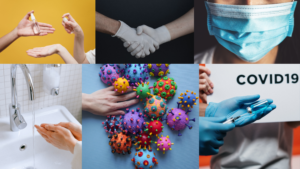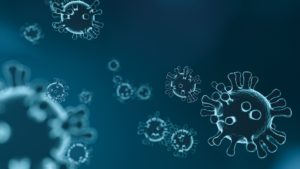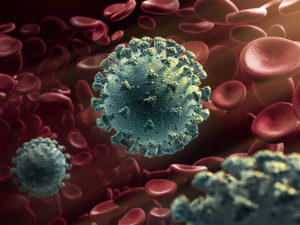NYU Langone Scientists Track Evolution of Coronavirus in New York City

NYU Langone researchers are entering the gene code from local viral samples into a global database that tracks the pandemic’s spread, a map of which uses circles of different colors and sizes to represent the different countries and the number of infections, respectively, connected by lines of transmission. PHOTO COURTESY OF NEXSTRAIN.ORG
Source: NYU Langone Health
As of April 9, NYU Grossman School of Medicine researchers have determined the genetic code for 2019 coronavirus disease (COVID-19) virus taken from 91 New York City patients, the most completed on the U.S. East Coast during the current pandemic, the researchers say.
Upon determining the order of the genetic letters in the codes from the local viral samples, also called their “sequences,” the researchers submit them to GISAID EpiFlu™, the Global Initiative on Sharing All Influenza Data. Founded in 2008 to promote the international sharing of data on influenza infections, the GISAID database is now tracking the evolution of the new coronavirus. The NYU Langone Health team determined the viral sequences from samples taken from the nasal swabs of patients at Tisch Hospital, NYU Winthrop Hospital, and NYU Langone Hospital—Brooklyn.
The early data suggest that the coronavirus has been spreading in the New York City community for a couple of months, researchers say, and before testing started. Further, the particular genetic codes in most local viral samples indicate that they originated in Europe.
“The value of determining viral local sequences is that the more that become available, the better we can monitor the spread and severity of the disease, and the more it can clarify which drugs, vaccines, or social interventions are effective here,” says Adriana Heguy, PhD, director of the Genome Technology Center at NYU Langone and leader of the sequencing team. “We’re just starting this project, but will soon be sequencing 192 viral samples per week with the goal of offering thousands of sequences for analysis in the near future.”
“This global effort does not just determine the code of a single version of the virus, but tracks how its genetic code changes as it moves through a population, and with what consequences,” adds Matija Snuderl, MD, director of molecular pathology and diagnostics and associate professor in the Department of Pathology at NYU Langone. “As viruses evolve during transmission from person to person, their sequences can help researchers to zero in on the provenance, or place of origin, of that specific infection,” says Dr. Snuderl, who leads the clinical testing team.
“Slight changes in the genetic code of a virus that happen during transmission from person to person can help to guide the public health response,” says Matthew T. Maurano, PhD, member of the Institute for Systems Genetics and assistant professor in the Department of Pathology at NYU Langone. In the case of the samples from patients sequenced so far, Dr. Maurano’s comparisons with other GISAID sequences showed that they lie in multiple independent groups of COVID-19 cases from the United States, Europe, and Asia.
Named severe acute respiratory syndrome coronavirus 2 (SARS-CoV-2), the new virus causes the disease called COVID-19. As of April 9, it had infected nearly 1.5 million people worldwide. According to the World Health Organization, the illness has resulted in nearly 89,000 deaths to date, more often among older patients with underlying health conditions. The New York State Department of Health has reported more than 76,000 cases to date in New York City.
Capture Sequencing
Recent studies have determined that the SARS-CoV-2 virus contains a few proteins and a strand of RNA, a type of genetic material that, like a DNA molecular chain, encodes information as a sequence of chemical letters called nucleotides, the researchers say. The new coronavirus code has 29,900 nucleotides in total (its genome). Changes (mutations) occur in the code as viruses copy themselves after invading human cells, such that viral genomes continually, randomly evolve.
For the current project, the NYU Langone team used a technique called “capture sequencing” to determine the order of the RNA sequence for the virus from each patient sample. The team first used “baits”—pieces of genetic material designed specifically to attach to the SARS-CoV-2 RNA—to fish its sequence out of the mix of genetic material from organisms that live in each patient’s nose and throat.
Then the team used high-throughput machines to determine the sequences by breaking RNA chains into pieces, and using the enzyme polymerase to make a copy of each fragment attached to an identifying bar code tag. The machines then make vast numbers of copies, enough to be picked up by technologies that use glowing probes to identify each letter in order.
“Capture sequencing has enabled us to instantly sample all genes in all organisms present in a complex patient sample, and to more accurately identify ongoing changes in genes,” says Dr. Heguy.
Also a key member of multidisciplinary team that made the sequencing possible was Mark J. Mulligan, MD, director of NYU Langone’s Vaccine Center. His team helped to develop the clinical SARS-CoV-2 test used by NYU Langone’s pathology team.
Media Inquiries
Greg Williams
Phone: 212-404-3500
gregory.williams@nyulangone.org



